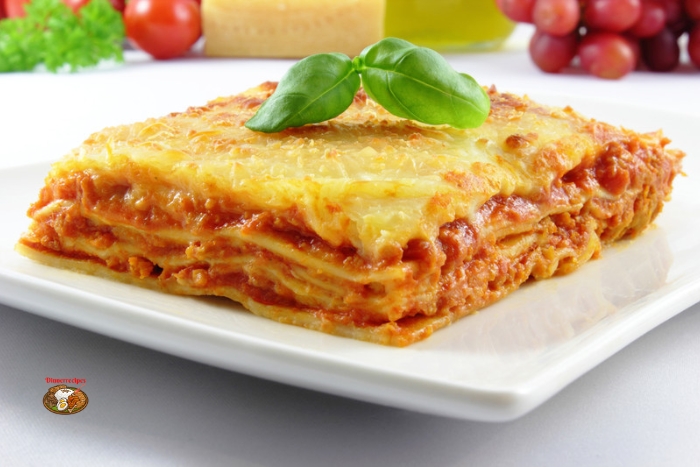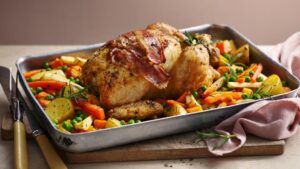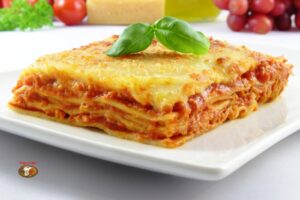The Origins of Lasagna alla Bolognese
Before diving into the recipe itself, it’s important to understand where Lasagna alla Bolognese comes from. Lasagna is an ancient Italian dish, with roots stretching back to the Roman Empire, but the version that we recognise today as Lasagna alla Bolognese comes from the city of Bologna in northern Italy. Bologna is renowned for its rich culinary heritage, and the combination of lasagna with Bolognese sauce – a slow-cooked meat ragù – is a true expression of the region’s gastronomic traditions.
The dish has evolved over time, but its essence remains the same: layers of fresh pasta interspersed with rich ragù, béchamel sauce, and cheese. While Lasagna alla Bolognese is a favourite dish in Italy, it has been embraced globally and adapted in various ways. However, to truly honour this dish, it is important to stick to its traditional ingredients and preparation techniques.
Lasagna alla Bolognese Recipe
Ingredients
For the Ragù (Bolognese Sauce)
- 500 g beef mince preferably lean, but a mix of beef and pork can be used for added richness
- 250 g pork mince optional, but traditional in some versions
- 1 medium onion finely chopped
- 1 medium carrot finely chopped
- 1 stick celery finely chopped
- 2 cloves garlic minced
- 1 can 400g plum tomatoes or crushed tomatoes
- 100 ml dry white wine
- 200 ml whole milk
- 1 tbsp tomato purée
- Olive oil for frying
- Salt and pepper to taste
- Fresh thyme or bay leaves optional
- 1-2 tbsp Italian seasoning optional, but can be added for extra depth of flavour
For the Béchamel Sauce:
- 50 g unsalted butter
- 50 g plain flour
- 600 ml whole milk warmed
- A pinch of grated nutmeg
- Salt and pepper to taste
- 1 tbsp grated Parmesan cheese optional, for extra flavour
For the Lasagna:
- 300 g fresh lasagna sheets alternatively, dried pasta can be used
- 150 g grated Parmigiano Reggiano for layering
- Mozzarella cheese optional, for extra creaminess
Instructions
Preparing the Ragù (Bolognese Sauce)
- Heat olive oil in a large, heavy-bottomed pot over medium heat. Add the finely chopped onion, carrot, and celery, and cook until softened and translucent, about 8 minutes. Stir occasionally to prevent sticking.
- Add the garlic and cook for a further minute until fragrant.
- Add the minced beef and pork (if using) to the pot. Increase the heat slightly to brown the meat. Break up the meat with a wooden spoon, ensuring it cooks evenly. Once browned, remove any excess fat.
- Deglaze the pan with white wine, scraping up any browned bits from the bottom of the pot. Allow the wine to reduce by half, which will concentrate the flavours.
- Stir in the tomato purée, then add the canned tomatoes, breaking them up with the spoon. Add a pinch of salt, freshly ground black pepper, and any herbs you’re using (such as thyme or bay leaves).
- Simmer gently over low heat for about 1.5 to 2 hours, stirring occasionally. The sauce should thicken and the flavours should meld together. If it gets too thick, add a splash of water or broth to adjust the consistency. Taste and adjust the seasoning as necessary.
- Add the milk gradually, stirring to combine. This step helps mellow the acidity of the tomatoes and gives the sauce its rich, velvety texture. Continue cooking for another 30 minutes, stirring often.
- Once your ragù is ready, set it aside to cool slightly.
Preparing the Béchamel Sauce
- Melt the butter in a saucepan over medium heat. Once melted, add the flour and whisk continuously for about 2 minutes, forming a smooth roux (paste). This cooks out the raw taste of the flour.
- Gradually add the warmed milk, whisking constantly to avoid lumps. Continue to cook the mixture over medium heat, whisking occasionally, until it thickens to the consistency of heavy cream.
- Season with salt, pepper, and a pinch of grated nutmeg. Remove from the heat once the sauce is thickened and smooth. Stir in a tablespoon of grated Parmesan if desired for extra flavour.
- Set aside to cool slightly before using.
Assembling the Lasagna
- Preheat the oven to 180°C (160°C fan)/350°F.
- If using dried lasagna sheets, cook them according to the package instructions. For fresh pasta, there’s no need to pre-cook the sheets, though you can quickly blanch them in boiling water for a minute or so to soften them if preferred.
- Begin layering your lasagna: Start by spreading a thin layer of ragù at the bottom of a large baking dish.
- Place a layer of lasagna sheets over the ragù, ensuring they cover the sauce completely. You may need to trim the edges slightly to fit the dish.
- Spread a generous layer of béchamel sauce over the pasta sheets, followed by a spoonful of ragù.
- Sprinkle some grated Parmigiano Reggiano over the top and add another layer of lasagna sheets.
- Repeat the process, alternating between ragù, béchamel, and pasta sheets, until all components are used up. Ensure the top layer is covered with béchamel sauce and a generous amount of Parmesan cheese.
- Bake in the preheated oven for 30-40 minutes, or until the top is golden and bubbling, and the lasagna is hot all the way through.
- Allow the lasagna to rest for 10-15 minutes before serving. This helps the layers set, making it easier to slice and serve.
Step 4: Serving Your Lasagna alla Bolognese
- Once your Lasagna alla Bolognese has rested, it’s ready to be served. Slice into generous portions and serve with a simple side salad, perhaps dressed in olive oil and balsamic vinegar, and a glass of red wine. The dish is perfect for family gatherings, special occasions, or as a comforting weeknight meal.
Notes
Tips for the Perfect Lasagna alla Bolognese
- Slow-cook the ragù: The longer you cook the ragù, the better the flavours will develop. If you have the time, consider making the sauce a day ahead and letting it rest overnight. The flavour will deepen and improve.
- Use fresh pasta: While dried pasta can be used, fresh pasta makes a big difference in the texture and overall quality of the dish. Fresh lasagna sheets are often available in Italian delicatessens and supermarkets.
- Don’t skimp on the cheese: Use high-quality Parmigiano Reggiano and mozzarella for the best flavour and texture. A good-quality cheese will bring depth to the dish and contribute to its richness.
- Rest the lasagna: After baking, let the lasagna rest for 10-15 minutes before cutting. This helps the layers set, making it easier to serve and enhances the flavours.
- Customize your ragù: While traditional Bolognese uses a combination of beef and pork, feel free to adjust the meat according to your preference. Some people even add a small amount of pancetta for extra flavour.
- Freezing Lasagna: Lasagna can be made in advance and frozen before baking. Wrap it tightly in foil or plastic wrap, and when ready to bake, cook it directly from frozen, adding an extra 15-20 minutes to the cooking time.
Additional Notes:
- If you use low-fat cheese or opt for a lighter béchamel (with reduced butter or using a milk alternative), you can reduce the calorie count.
- For a vegetarian version (replacing meat with lentils or mushrooms), the calorie count can be lowered as well.
Variations of Lasagna alla Bolognese
While the classic Lasagna alla Bolognese recipe is perfect as it is, there are a few variations and creative twists you might want to try. Here are a few options to inspire you:
- Vegetarian Lasagna alla Bolognese: Substitute the meat ragù with a vegetable-based sauce made from mushrooms, lentils, or a mixture of roasted vegetables. This is perfect for vegetarians or those looking to reduce their meat consumption.
- Lasagna with Spinach: Add cooked spinach or other greens between the layers for a slightly different flavour and texture. Spinach also adds a lovely pop of colour to the dish.
- Seafood Lasagna: For something a little more decadent, a seafood lasagna can be made using a white sauce and a mixture of shrimp, crab, and other shellfish. This version is especially popular in coastal regions of Italy.
Conclusion
Lasagna alla Bolognese is a dish that encapsulates the heart of Italian cooking: rich, comforting, and full of flavour. By following these detailed steps and using high-quality ingredients, you can recreate this classic dish at home and enjoy the taste of Italy in your own kitchen. Whether you’re cooking for a family dinner or a special occasion, Lasagna alla Bolognese is sure to impress and satisfy.
With a little patience and care, you’ll soon master this traditional recipe and become the proud creator of one of Italy’s most beloved culinary treasures. Buon appetito!



















